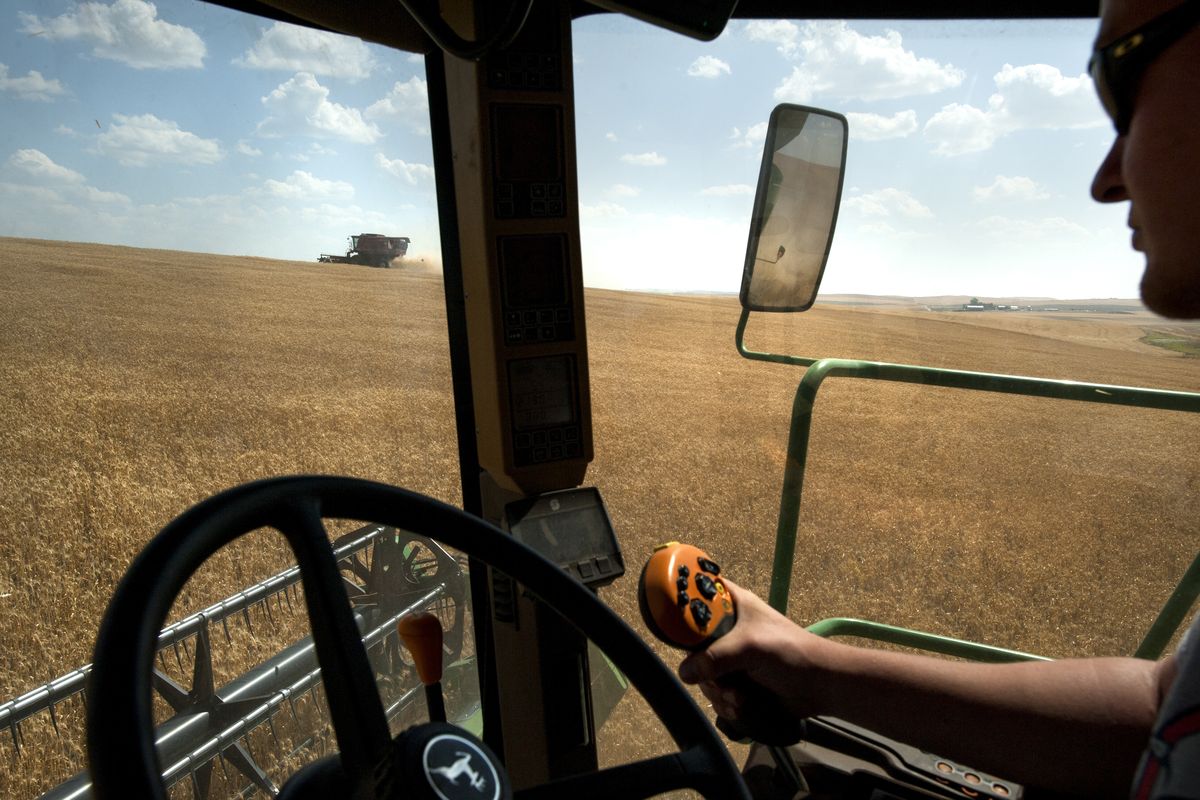Dry, warm weather taking toll on wheat crops

REARDAN, Wash. – From his perch in the combine, Joel Zwainz lowered the reel even closer to the ground. This patch of winter wheat, he said, is normally about 10 inches tall, and even cutting at 4 inches, he’s still not picking up most of the grain.
“It’s no fun to harvest here,” he said. “It’s kind of hard because it’s so low. Right now, I’ve got my reel down as low as it’ll go, and if I take my header any lower, it’ll be digging dirt.”
Zwainz and his father, Tom, were harvesting a section of wheat Monday that showed all the signs of a year with too much heat and too little rain. With about a week left of harvest on his family’s sprawling 3,400-acre farm near Reardan, they estimated a 30 to 50 percent drop from last year’s yields.
“Historically, recropped winter wheat has done very well for us, but this year with the lack of moisture, it just didn’t,” Joel Zwainz said, adding, “No one’s bragging about their yields this year.”
Uncooperative weather across the Inland Northwest has hindered this year’s wheat crop, which farmers estimate is down an average of about 30 percent from last year’s yield and slightly below the 10-year average.
In addition, the summer’s extreme heat and drought has rendered the crop potentially less tasty to foreign customers who make up as much as 90 percent of the market for Washington wheat.
“We’ve had wonderful crops the last few years – this year, not so much,” said Scott Yates, of the Washington Grain Commission.
Farmers in recent years have seen superb harvests boosted by favorable grain prices and fair weather, but sporadic rain and heat has contributed to a less-than-ideal crop and frustrated dryland farmers who rely entirely on rainfall for moisture.
Much of the Columbia Basin is in moderate to severe drought, according to this week’s report from the U.S. Drought Monitor. One or two more rains during May or June could have made a huge difference, Yates said.
“They’re literally million-dollar rains,” he said. “If you get the moisture at exactly the right time, it doesn’t matter if you’re 2, 3, 4 inches behind.”
The trouble began for some farmers as early as last fall, when winter wheat – three-fourths of the wheat grown in the state – goes into the ground. In drier areas, winter wheat is planted deeper in the soil to collect moisture.
But significant rainfall “crusted” the powdery soil at the surface before the plant could break through the ground, Yates said, forcing some farmers to replant the crop two or three times.
A cold spell followed in December that damaged portions of the crop left exposed to the chill by a lack of snowfall, which normally blankets and protects it through winter. On the Zwainz farm, the ground was so frozen that any rainfall during the winter ran off into nearby creeks. That dryness was compounded by an unusually dry spring and summer, Zwainz said, and temperatures that reached triple digits in July.
Keith Bailey, general manager of the AgVentures NW LLC, which receives and stores grain from farmers, including Zwainz, said the 30 to 40 percent drop from last year is a “significant bar to hurdle” in a business that earns revenue primarily from volume of wheat harvested.
“It’s just one of those years you’ve got to buckle down and tighten your belts,” Bailey said.
Thankfully, Yates said, the most recent storms and wind have had little impact on harvest operations, which he estimated came about two weeks ahead of schedule for most farmers in the state in part because of the heat. Typically ending mid-September, the harvest last week was about 75 percent done, according to estimates by Northwest Grain Growers.
But the heat and drought could disappoint buyers in North Africa, Middle East and Asia who find the state’s soft white wheat – low-protein kernels that comprised 82 percent of the state’s wheat crop in 2013 – delectable because its consistency is preferred for sponge cake, flatbreads, pastries and pancakes.
But this year’s soft white crop, stressed by the heat, is one or two grams higher in protein, Yates said, meaning the kernels will be more textured and chewy.
“Consumers are still going to take their soft white, but they’re going to have to change how they use it,” he said.
Japan was last year’s big buyer, followed by Nigeria, Mexico, the Philippines and Egypt.
In 2012, wheat was the state’s second-most lucrative farm product – well behind apples and just ahead of milk – bringing in $1.18 billion.
This year, prices for soft white wheat sit at about $7 a bushel, and experts predict it could fall to $6.50 a bushel if Australia’s competing crop turns out larger than expected. Production increases in Europe and Asia could also lower prices.
Yates said it’s hard to determine the break-even price for Washington farmers because every situation is different.
“Some could probably make money at $5, but most people aren’t that fortunate,” Yates said. “They’re paying on equipment and land, and they need a substantially higher price to actually make money.”
Zwainz said growing profitable crops year to year depends on the size of the farm. His family has hedged against risk by diversifying types of wheat and sharing resources, like the $500,000 combine harvester, with extended family.
But sometimes, he said, there’s nothing that can prevent a bad year.
“Not every year can be a great year,” he said. “You gotta take the good with the bad. You always hope for the good, but every now and then you’re gonna be dealt cards you don’t really like, and you’re just going to have to make it work.”